Home Improvement
BEST MATERIAL FOR RESTAURANTS PATIO FURNITURE

Table of Contents
1. WOOD
For thousands of years, wood has been a widely used raw material for restaurant patio furniture. It is naturally beautiful, typically simple to work with, and offers a strong structure for furniture such as benches, tables, and chairs. However, when it comes to outdoor use, not all woods are made equal. Many softwoods, including pressure-treated pine, cedar, and fir, are frequently used for indoor furniture but are pricey, do not fare well against the weather, and require continual care while not in use. Hardwoods, however, are far more robust, resist weather damage, and, if properly cared for, may survive for decades. On the downside, they are often more costly than softwoods and are frequently harder to form. But there are also significant variations among hardwoods.
2. TEAK
The most common type of wood for outdoor furniture is, without a doubt, teak. This fine-grained hardwood is expensive because of its great demand and scarcity. Fortunately, teak possesses various qualities that make it perfect for outdoor use. Like many types of wood, it is exceptionally robust and doesn’t warp, split, or become brittle. restaurants patio furniture is because teak is primarily water-resistant and does not swell or shrink during drying. Due to its high natural oil content, it is very resistant to harm from insects, rot, and decay.
3. SHOREA
One of the few hardwoods that are both heavier and stronger than teak is this reddish-gold Southeast Asian timber. Its strength (modus of rupture) and flexibility (modus of elasticity) are enhanced by heat exposure [Noh & Ahmad 2017]. Like many other hardwoods used for outdoor furniture, the harvesting of Shorea (also known as meranti) is strictly controlled to protect its sustainability. Its high oil content makes it resistant to weather damage, less susceptible to rotting and protected against insects. Shorea lasts up to fifty years and, like teak, develops a silver-gray patina if the wood is not routinely oiled. Its cost is considerably cheaper, though. The single significant disadvantage of shorea is that few merchants sell it, partly because of consumer apathy.
4. EUCALYPTUS
This sturdy Australian hardwood is fast-growing, durable, and far less expensive than teak. Its rustic charm derives from its naturally washed look, which, if not routinely oiled, will turn into a silver patina. It resists decay and weather, and its oil is a natural pesticide. However, a sealer is advised to lessen the harmful effects of irregular moisture retention and increase the eucalyptus’ resilience to pests.
5 IPE
Contrary to many of its hardwood equivalents, ipe (also known as ironwood) from Central and South America has a deep, richly colored grain that ages more slowly when exposed to the elements [Jankowska, Reder, Goofit 2017]. It has a high natural oil content, which aids in its resistance to insects, rot, and fungus. Its robust, thick structure protects it from physical harm, including denting, warping, and breaking. Despite having a lifespan of up to 40 years, cutting and gluing together, ipe needs a lot of preparation.
6. WHITE OAK
This plentiful wood is more durable than most and more substantial and demanding than others. Due to its structural capacity to repel water, which also aids in its resistance to decay, it has long been used to construct boats. It lacks a lot of natural oil and needs paint or a sealer to stay durable. Whitewood left untreated over time has a lovely grey patina.
7. OTHER HARDWOOD
Many other hardwoods are available for significantly less money and share some of the advantages of teak. Nevertheless, they also have disadvantages compared to the hardwoods mentioned earlier. Although easily accessible, reddish-brown acacia, sometimes known as locust, is more likely to distort or break than shorea or eucalyptus. African iroko is extremely difficult to work with, quickly splinters, and dulls woodworking equipment, but roble is rare, lightweight, and lasts half as long as teak. Mahogany is abrasive, needs a lot of upkeep, and doesn’t resist rot or teak, despite having a lovely reddish hue.
Read more – Tips For Maintaining Your MR Grade Plywood Furniture And Doors

-

 Business3 years ago
Business3 years agoHow to Do Long-Distance Moves with Children
-

 Travel2 years ago
Travel2 years agoQuick Guide: Moving To Santa Rosa?
-

 Real Estate3 years ago
Real Estate3 years agoWhy Dubai Festival City is a Great Neighbourhood for Young Learners
-

 Business3 years ago
Business3 years agoIs Guest Posting a Good Inbound Marketing Strategy?
-

 Business1 year ago
Business1 year agoThe Ultimate Guide To Thriving In Your Printing Franchise
-

 Business1 year ago
Business1 year agoExploring The Benefits And Challenges Of Restaurant Franchising
-

 Tech3 years ago
Tech3 years agoCyber Table That Will Change Your Life
-

 Lifestyle1 year ago
Lifestyle1 year agoDallas’ Hidden Gems: 6 Must-Try Restaurants Off The Beaten Path!









Recent Comments